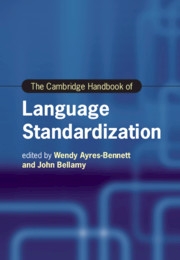Book contents
- The Cambridge Handbook of Language Standardization
- cambridge handbooks in language and linguistics
- The Cambridge Handbook of Language Standardization
- Copyright page
- Contents
- Figures
- Tables
- Contributors
- Introduction
- Part I Revisiting Models and Theories of Language Standardization
- Part II Legitimacy, Authority and the Written Form
- Part III Norms, Literacy and Education
- Part IV Beyond the National
- 19 Transnational Standards of Languages
- 20 Standardization across State Boundaries
- 21 Language Modernization in the Chinese Character Cultural Sphere
- 22 Linguistic Norms, Centre–Periphery Dynamics and the Tension between Uniformity and Diversity in Processes of Standardization
- 23 When Ethnic Boundaries and Language Boundaries Mismatch
- 24 The Standardization of a Stateless Language
- Part V Standardization in Late Modernity
- Name Index
- Subject Index
- References
20 - Standardization across State Boundaries
Modern Ukrainian as a Paradigmatic Case
from Part IV - Beyond the National
Published online by Cambridge University Press: 01 July 2021
- The Cambridge Handbook of Language Standardization
- cambridge handbooks in language and linguistics
- The Cambridge Handbook of Language Standardization
- Copyright page
- Contents
- Figures
- Tables
- Contributors
- Introduction
- Part I Revisiting Models and Theories of Language Standardization
- Part II Legitimacy, Authority and the Written Form
- Part III Norms, Literacy and Education
- Part IV Beyond the National
- 19 Transnational Standards of Languages
- 20 Standardization across State Boundaries
- 21 Language Modernization in the Chinese Character Cultural Sphere
- 22 Linguistic Norms, Centre–Periphery Dynamics and the Tension between Uniformity and Diversity in Processes of Standardization
- 23 When Ethnic Boundaries and Language Boundaries Mismatch
- 24 The Standardization of a Stateless Language
- Part V Standardization in Late Modernity
- Name Index
- Subject Index
- References
Summary
Throughout its existence, Ukrainian has been a language of more than one state. At the time of the formation of its modern standard (nineteenth and the first half of the twentieth centuries), the Ukrainian ethnic territory was divided between the Austrian and Russian empires, leading to the rise of two distinct varieties: eastern and western. Apart from different dialect bases, these two standards contrasted with respect to the type of interdialectal language variety immediately preceding them: folklore and urban koine, respectively. Despite the coexistence of two standards, Ukranian was not a bi- or pluri-centric language strictu sensu, as its development was characterized by a good deal of acentricity. Cross-border cooperation and periodical border shifts contributed to partial levelling of differences, especially during the interwar years, when contacts between the two traditional varieties were intensified in all of the countries (partly) inhabited by Ukrainians: the Soviet Union, Poland, Romania and Czechoslovakia. The corpus-planning centres for Ukrainian in each country were of different types (powerful, weak, dictatorial). After the reunification of the bulk of Ukrainian lands within the Soviet Union (1945) and following the proclamation of the country’s independence (1991), homogeneity of the standard was achieved, although ancient state boundaries continue to be felt.
Keywords
- Type
- Chapter
- Information
- The Cambridge Handbook of Language Standardization , pp. 546 - 575Publisher: Cambridge University PressPrint publication year: 2021



